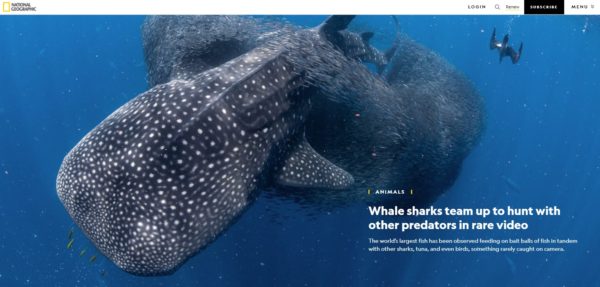今回の世界の海ザッピングはジンベイザメのお話。
少し前になるのですが、ナショナルジオグラフィックの記事で、ジンベイザメが集団で狩りをしているというのが記事になっていました。
ジンベイザメは時期によっては一つのエリアに集まってくることがありますが、基本的には単体で行動しているので、集団でいることは珍しく、また、集団で狩りをしているのもさらに珍しいんです。
また、今回は狩りで何を狙っているかと言うと、小さい魚なのです。ジンベイザメはオキアミなどの小さい甲殻類を主に食べているので、このような行動がみられるのは本当に貴重なものなのです。

===========================
Whale sharks, the world’s largest fish, spend much of their time swimming slowly, swallowing mass quantities of tiny creatures such as krill, as befits such a colossal filter-feeder. But this portrait is incomplete—the giants have more complex hunting habits than previously thought.
New observations in Western Australia’s Ningaloo Reef show these animals can hunt in tandem with other predators including tuna, other sharks, and even diving seabirds. In a recent clip, captured in March 2020 by photographer Tom Cannon, at least three whale sharks were seen swooping in on a ball of baitfish, a behavior rarely caught on camera.
“I’ve watched the footage hundreds of times, and it still blows my mind,” says Emily Lester, a postdoctoral fellow at the Australian Institute of Marine Science and lead author of a research article, publish in February that details the encounter.
While krill and other plankton make up the bulk of whale sharks’ diets, scientists have long known that small fish like anchovies and sardines—and even the occasional squid—do appear on the menu. Pinning down the specifics of when, where, and why these animals opt for more sizable sustenance, however, is a difficult task.
“Whale sharks can be really challenging to study despite their huge size because they’re so mobile,” says Lester. Not only can the behemoths swim across entire oceans, they’re also known to dive thousands of feet beneath the surface.
Whale shark meetups like the one at Ningaloo—which occurs each year between March and August—offer a unique opportunity for scientists and ocean enthusiasts to observe these elusive animals in shallow, nearshore waters. Even then, notes Lester, happening upon a feeding event like this is akin to finding a needle in an ocean-sized haystack.
===========================
世界最大の魚であるジンベイザメは、そのような巨大なろ過摂食動物にふさわしく、オキアミなどの小さな生き物を大量に飲み込んで、ゆっくりと泳ぐことに多くの時間を費やしています。しかし、この光景はそれに当てはまりません。巨大な生物は以前考えられていたよりも複雑な狩猟習慣を持っています。
西オーストラリアのニンガルーリーフでの新しい観察によると、これらの動物は、マグロ、他のサメ、さらにはダイビングする海鳥などの他の捕食者と一緒に狩りをすることができます。 2020年3月に写真家のトムキャノンが撮影した最近のクリップでは、少なくとも3匹のジンベイザメがベイトフィッシュのボールに急降下しているのが見られました。
「私は何百回も映像を見てきましたが、それでも心を打たれます」とオーストラリア海洋科学研究所のポスドクであり、研究記事の筆頭著者であるエミリー・レスターは2月に見た光景の詳細を発表しました。
オキアミやその他のプランクトンがジンベイザメの食事の大部分を占めていますが、科学者たちは、カタクチイワシやイワシ、場合によってはイカなどの小魚が捕食されることを長い間知っていました。しかし、これらの動物がより大きな栄養を選ぶ時期、場所、理由の詳細を特定することは困難な作業です。
「ジンベイザメはサイズが大きいにもかかわらず、非常に行動範囲が広いため、研究するのが非常に難しい場合があります」とレスターは言います。ジンベイザメは海全体を泳ぐことができるだけでなく、水面下で数千フィートも潜ることで知られています。
ニンガルーで行われるようなジンベイザメの交流会は、毎年3月から8月に開催され、科学者や海洋愛好家が浅い沿岸海域でこれらのとらえどころのない動物を観察するユニークな機会を提供します。それでも、レスターは、このような摂食イベントで起こることは、海の大きさの干し草の山で針を見つけることに似ていると述べています。
===========================
是非、原文のページに動画もアップされていますので、見てみてくださいね♪
【原文のページはこちらから↓】
https://www.nationalgeographic.com/animals/article/whale-sharks-can-hunt-with-other-sharks-feed-on-bait-balls

